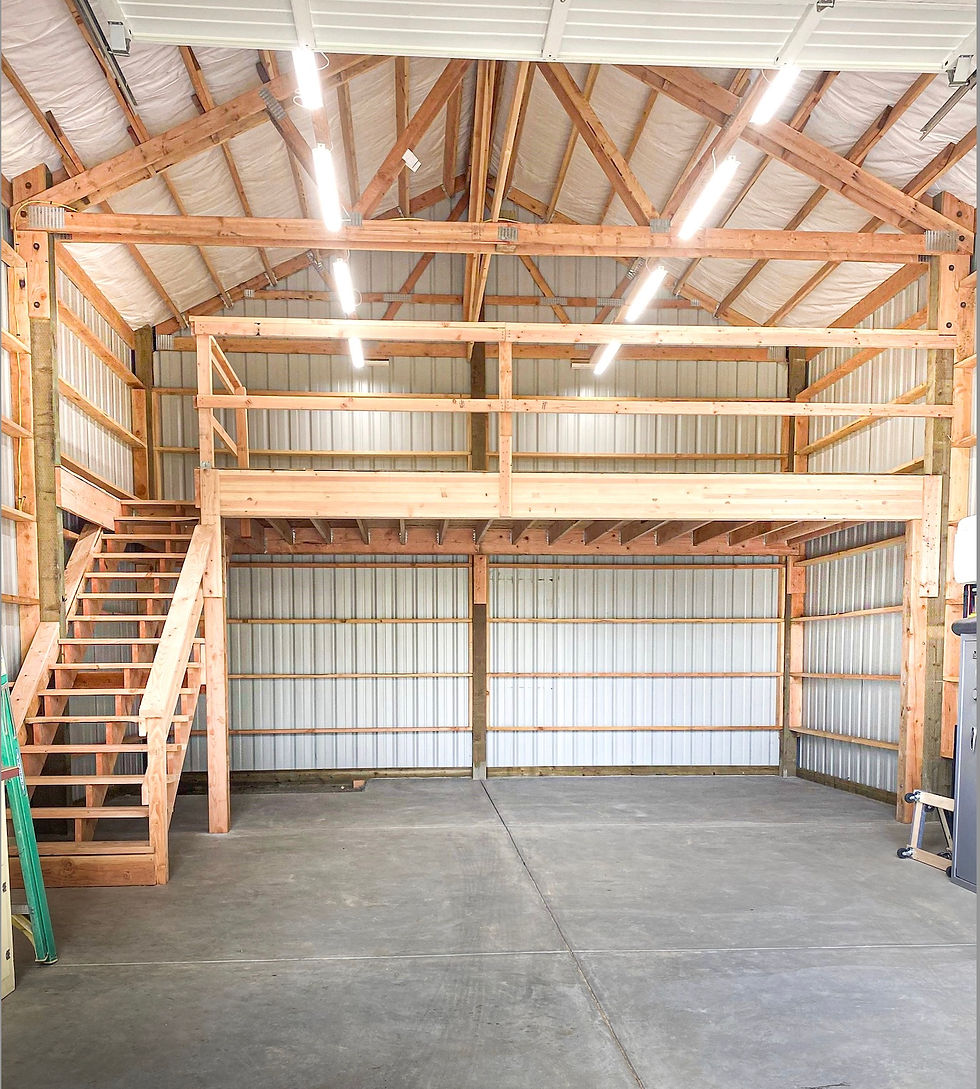Maximizing Storage Space in Your Pole Barn with Smart Design Choices
- Julian Garber

- Feb 21
- 4 min read
When it comes to building a functional, durable, and cost-effective structure, few options rival the versatility of a pole barn. Whether you need a workspace, a place to store farm equipment, or extra room for hobbies and recreational vehicles, a pole barn can be tailored to your needs—both in looks and functionality. At VWC Construction, we understand the importance of making the most of every square inch. Below, we’ve compiled some of our favorite design tips to help you maximize storage space in your pole barn.
1. Plan for Purpose
Before breaking ground, it’s essential to have a clear vision of what your pole barn will be used for. Whether it’s machinery, livestock, tools, or oversized vehicles, your primary purpose should influence every step of the design process. By considering the types of items you’ll store and the frequency of use, you can choose proper bay widths, door sizes, and layout configurations that optimize the available space.
Assess your inventory: Make a list of all the items you plan to store, including approximate dimensions.
Plan for future needs: If you anticipate needing more space down the road, consider making the barn slightly larger now.

2. Focus on Vertical Storage
Too often, pole barn owners overlook the potential of vertical space. One of the simplest ways to unlock more storage is to think upwards.
Tall Ceiling Heights: Opt for a taller ceiling during construction. This extra overhead clearance allows for lofts, overhead racks, or suspended shelving that can keep frequently used floor space free.
Lofts & Mezzanines: Incorporating a loft or mezzanine is a great way to create separate zones within your barn. Use the upper level for less frequently used items or seasonal supplies, freeing up ground-level areas for daily tasks.
Wall-Mounted Storage: Sturdy wall-mounted shelving, hooks, or pegboards can go a long way in organizing tools and equipment.

3. Optimize Door Placement and Size
A large overhead door makes it easier to accommodate big equipment, but proper door placement can also significantly impact how you maneuver within the space.
Consider Traffic Flow: If multiple vehicles or large pieces of equipment will be moving in and out, two or more strategically placed doors can help.
Sliding vs. Overhead Doors: Overhead doors are more common, but sliding doors can sometimes save overhead space or offer a larger opening without needing additional headroom. Discuss your specific needs with our team at VWC Construction to find the right fit.

4. Make Use of Natural Lighting
Adequate lighting doesn’t necessarily create more square footage, but it does help you use every corner effectively. Dark and dimly lit buildings often have underutilized areas simply because items or tools get hidden away.
Windows & Skylights: Strategically placing windows can flood your pole barn with natural light, reducing the need for extensive artificial lighting while improving visibility and functionality.
LED Lighting: For year-round usage or long winter nights, install efficient LED lighting to ensure every corner is well-lit.

5. Invest in Custom Shelving and Built-Ins
While standard shelving units are readily available, custom shelving designed with your needs in mind can dramatically increase organization and available space. Custom-built solutions can be tailored around your equipment or storage totes, eliminating awkward gaps or wasted corners.
Adjustable Shelving: This allows you to reconfigure shelving heights as your needs change over time.
Built-In Cabinets: Sturdy cabinets can safeguard sensitive tools or materials from dust, dirt, or pests.

6. Create Dedicated Zones
A spacious pole barn can quickly become cluttered if items don’t have a designated place. Think of your barn like a home workshop or garage—everything is easier to find and use when it’s organized into specific zones.
Work Area: Keep tools and frequently used machinery near your main entry or workbench.
Storage Area: Assign a separate area for long-term or seasonal storage, such as RVs or holiday decorations.
Maintenance & Repair Zone: Include a well-lit space with a sturdy workbench and tool chest for repairs and routine maintenance.
7. Don’t Overlook the Exterior
Sometimes, the best way to free up interior space is to take some of your storage options outside.
Lean-To Structures: Adding a lean-to on one or more sides of your pole barn can create covered outdoor storage for tractors, trailers, and more, leaving valuable indoor real estate open for other uses.
Covered Porches: A porch or canopy can serve as a staging area or a protected space for items better kept outdoors.

8. Choose Quality Materials for Long-Term Value
Maximizing your storage potential also means ensuring that your pole barn remains sturdy and reliable over time.
Foundation & Flooring: Consider a properly prepped site and durable flooring (like concrete) that can handle heavy loads.
Insulation & Ventilation: Good insulation and ventilation help protect stored items from moisture damage while making the barn more comfortable to work in.

Partner with VWC Construction for Expert Guidance
Designing a pole barn to meet your unique storage needs is both an art and a science. At VWC Construction, we bring years of experience to the table to help you plan, build, and finish a structure that stands the test of time. From the initial concept to the final inspection, our team works closely with you to ensure every detail—from ceiling height to door placement—is carefully considered.
Ready to get started on your pole barn project? Contact VWC Construction today to discuss your vision and learn how we can help you maximize storage space through smart, efficient design. Let us guide you in creating a pole barn that not only meets your current needs but also adapts as they evolve.




Comments